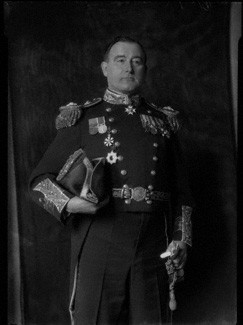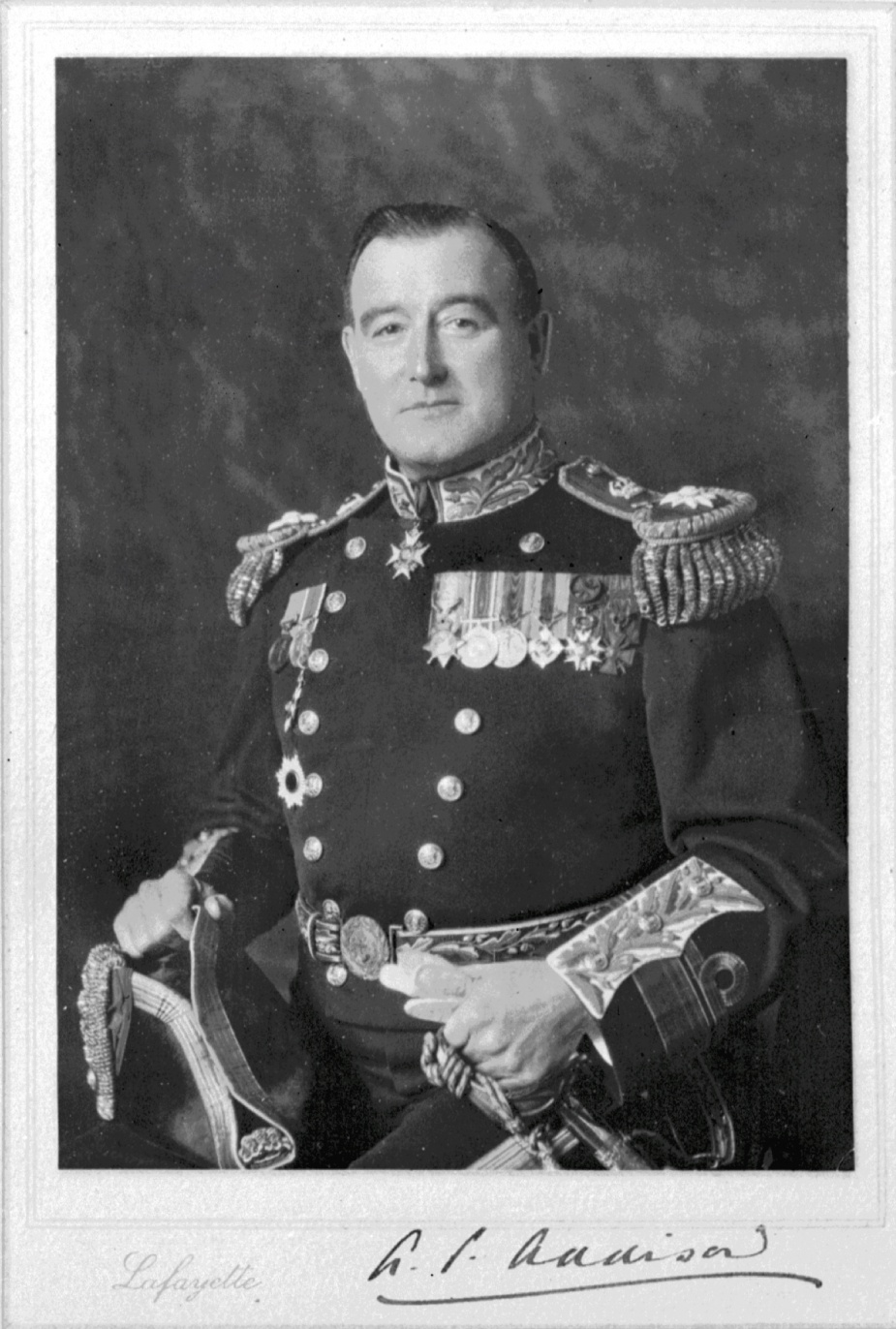Admiral Sir Albert Percy Addison KBE CB CMG

Commander, Australian Fleet (1922–1924)
Albert Percy Addison was born at Southsea, in England, on 8 November 1875, and entered the Royal Naval College, Britannia as a naval cadet on 15 July 1889.
Upon graduating from the naval college in July 1891, he served as a midshipman in the armoured cruiser HMS Warspite before joining the corvette HMS Garnet, then part of the Pacific Squadron, in January 1893. While serving in Garnet off the west coast of Canada, he was commended for rescuing a sailor who was lost overboard during a storm. He was subsequently awarded a Royal Humane Society Silver Medal, on 17 January 1894, for his bravery.
In September 1894, he was appointed to the battleship HMS Resolution and was promoted to acting sub lieutenant on 14 March 1895. During 1895 and 1896 he undertook training courses at the Royal Naval College, Greenwich, HMS Vernon and at Whale Island (HMS Excellent). He briefly commanded the first-class torpedo boat TB 71 in July 1896 for a training exercise, before joining the destroyer HMS Hardy in August 1896. In November 1896, he was appointed to the battleship HMS Revenge.
While serving in Revenge in the Mediterranean, he was awarded a Royal Humane Society Bronze Medal for rescuing another member of the ship's company. The citation read: ‘At great personal risk rescued HC Munroe from drowning at sea, South West of Crete, on 14 April 1897’. He was promoted to lieutenant on 14 June 1897 and subsequently qualified as a torpedo officer after training at HMS Vernon in 1898. Addison remained at Vernon as a member of staff until joining the battleship HMS Victorious in January 1901.
Victorious operated in the Mediterranean, and Addison spent two and a half years in the ship until being appointed to the torpedo boat destroyer flotilla at Chatham in July 1903. He commanded the first-class torpedo boat destroyer TB 110 during July and August 1903 for annual manoeuvres.
As a torpedo specialist, he chose to qualify as a submariner and spent the next three years serving in the early B-class submarines operated by the Royal Navy. In November 1906, he took command of the former torpedo gunboat HMS Hazard, which had been converted to a submarine tender in 1901 and was based at Portsmouth. He was appointed to HMS Mercury, and command of the Portsmouth Submarine Flotilla, on 20 November 1907 and was then promoted to commander on 31 December 1907.
He took command of the submarine depot ship HMS Forth, a former cruiser, in January 1909, and in November of that year he was appointed to command the submarine depot ship HMS Bonaventure. A year later, he was given command of the Dover Submarine Flotilla.
He was described by his superiors as ‘zealous, most capable and a strict disciplinarian’.
On 30 June 1913, he was promoted to captain and appointed as assistant to Commodore Roger Keyes RN, who commanded the 8th Submarine Flotilla, based at Harwich. At the outbreak of war in August 1914, he was loaned to the Admiralty to provide advice on the use of submarines, though in February 1915 he was appointed in command of the light cruiser HMS Carysfort, then being built at Pembroke Dock in Wales. Carysfort was commissioned in late June 1915 and attached to the 4th Light Cruiser Squadron of the Grand Fleet, operating in the North Sea.
In September 1915, he became the commanding officer of the light cruiser HMS Dartmouth, which was then serving in the Mediterranean. On 28 or 29 December 1915, an Austro-Hungarian naval force consisting of several cruisers and destroyers attacked the Albanian port of Durazzo. Dartmouth was part of a combined force of British, Italian and French warships that sailed from Brindisi in response to the attack and, during the ensuing battle, Dartmouth engaged the Austro-Hungarian cruiser SMS Helgoland in a long-range gunnery duel.
On 15 May 1917, while still commanding Dartmouth, he engaged three Austro-Hungarian cruisers in the Strait of Otranto as they were heading north to their home port. The enemy cruisers had attacked the Allied drifter line on 14 May 1917. This line of small vessels was operating in the strait as a boom to prevent enemy submarines entering the Mediterranean but with limited success. Fourteen of the lightly armed drifters were sunk and four more damaged before the enemy force broke of the action and sailed northwards.
An Allied force, including Dartmouth, located the fleeing enemy warships and Dartmouth fired a number of shells at the enemy cruisers in a running gun battle lasting several hours. Dartmouth was hit by several enemy shells and was forced to break off the action. As the British cruiser was returning to port she was torpedoed by the German submarine UC-25 and began to sink. Addison, and a small volunteer team of personnel, remained on board to operate the ships pumps while the stricken cruiser was towed to port.
Percy Addison was subsequently appointed as a Companion of the Order of St Michael and St George (CMG) ‘In recognition of his services in command of HMS Dartmouth during the pursuit of and running fight with Austrian cruisers which had attacked the Allied drifter line in the Straits of Otranto on the 15th May 1917 and especially for his excellent work in bringing his ship safely into port when she had been torpedoed by an enemy submarine on her passage back after the cruiser action was over’ (London Gazette, 29 August 1917). In addition to this, the Italian government made him a Cavalier of the Military Order of Savoy (London Gazette, 11 August 1917) for the same action.
With Dartmouth badly damaged and requiring several months in dry-dock for repairs, he returned to England and, in August 1917, took command of submarine depot ship HMS Maidstone and the 9th Submarine Flotilla, based at Harwich. The flotilla consisted of 16 E-class and 7 C-class submarines operating in the Dover Strait. On occasion, he went to sea with the flotilla on patrols. He was still in command of the 9th Flotilla when the war ended in November 1918.
For his war service, he was appointed as an Officer of the Legion of Honour (France) on 25 January 1918. He was also awarded the Japanese Order of the Rising Sun Third Class (London Gazette, 29 November 1918) and the French Croix de Guerre (London Gazette, 4 May 1920) for ‘distinguished service during the war’.
In January 1920, he was appointed in command of the battlecruiser HMS Lion but this was a brief command as, on 15 April 1920, he commenced service as the director of Torpedoes and Mining at the Admiralty.
He was appointed as commodore 1st class, commanding His Majesty’s Australian Fleet on 30 April 1922, taking over from Rear Admiral John Saumarez Dumaresq RN. He flew his flag in the light cruiser HMAS Melbourne for his period in command of the fleet, and was promoted to rear admiral on 2 November 1923.
During his time in command, the Australian Fleet was at its postwar zenith, consisting of three light cruisers and a fourth (HMAS Adelaide) commissioned in late 1922, six older River-class destroyers, six newer destroyers, three minesweeping sloops and six J-class submarines gifted by the Royal Navy. There were also a variety of auxiliary vessels, such as the submarine depot ship HMAS Platypus, the oiler Kurumba and the collier Biloela, supporting the fleet. The battlecruiser Australia was in reserve, and would eventually be scuttled on 12 April 1924 under the terms of the Washington Treaty on arms limitations.
The Australian fleet operated mainly on the Australia Station, with occasional visits to New Zealand, the Netherlands East Indies, Papua and New Guinea, Solomon Islands and the New Hebrides on ‘showing the flag’ cruises. Percy Addison relinquished command of the Australian Fleet on 30 April 1924, handing over to Commodore 1st Class Thomas Wardle DSO RN. After returning to England, he was appointed a Companion of the Order of the Bath (CB), on 3 June 1924, for his services to the Royal Australian Navy. He then served as Rear Admiral (Destroyers) in the Mediterranean Fleet from 1924 to 1926, commanding four destroyer flotillas and flying his flag in the cruiser HMS Coventry. During 1927, he completed the Senior Officers Technical Course at Portsmouth and the Senior Officers War Course at the Royal Naval College, Greenwich. His superiors noted that, while he was a capable commanding officer, he was an excellent administrator. He was appointed as the director of Dockyards and Repair at the Admiralty on 1 March 1928.
He was promoted to vice admiral on 28 February 1929 and placed on the Retired List at his own request on 1 March 1929. He did, however, remain as director of Dockyards and Repair until handing over to Vice Admiral Cecil Talbot on 1 May 1937.
He was appointed as a Knight Commander of the Order of the British Empire (KCB) on 3 June 1931 and promoted to admiral, on the Retired List, on 31 December 1932.
Soon after the outbreak of the Second World War, he was briefly recalled for service with the British government from September to November 1939, but otherwise remained in retirement during that war.
Percy Addison died at New Forest, in England, on 13 November 1952.



